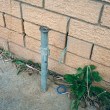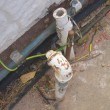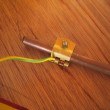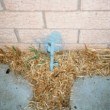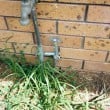A1.2 Electrical earth connection
An earth connection using an electrical earth stake is essential for the effective operation of electrical safety switches. If the house is not earthed, people could get electrocuted. Without an earth connection, the safety switches will not work and an electrical fault could cause a house or appliances to become ‘live’ as the current flows to earth.
Earth stakes often do not work because:
- there is poor or no connection between the electrical wire and the earth stake
- there is dry soil around the stake
- the earth stake is too short or not in contact with the ground at all
- the earth stake is corroded or damaged.
Design and Specification
Ensure
- A1.2.1.
the earth stake is long enough
- A1.2.2.
the earth around the stake is kept moist (do not locate earth stakes under a veranda or large roofed area, and consider locating them near a tap)
- A1.2.3.
the earth stake is made of copper or other approved, durable and solid metal rod, not galvanised pipe
- A1.2.4.
the earth stake, particularly the part above the ground, is protected from damage by vehicles, lawn mowers and weed trimmers
- A1.2.5.
the earth wire is securely attached with two clips
- A1.2.6.
where necessary, the installation may need to be two points of earth attachment.
Consider
- using multiple earth stakes or other earth connection methods when you live in a dry region; for example, an arid area earthing kit with soil additives to attract moisture to the earth stake (speak to the electrician about these options)
- installing additional or different power earthing arrangements if you have an on-site power generation system such as a fuel generator, renewable power system or hybrid energy systems.
Real world examples of Solutions
- A1.2.1.
Quality control
- the location, length and material of the earth stake

- COMPLETED DESIGN & SPECIFICATION
DURING CONSTRUCTION
- COMPLETED DESIGN & SPECIFICATION
- the connection of earth wire to earth stake (visual inspection only)

- AT HANDOVER
FINAL COMPLETION
- AT HANDOVER
- that the location of earth stake is included in the ‘as-built’ drawings of the house

- FINAL COMPLETION
- that the label for the location of the earth stake is clearly written in the switchboard with a permanent marker.

- AT HANDOVER
FINAL COMPLETION
TRADE TEST
- AT HANDOVER
- the earth wire connection to the earth stake, and ensure that there are two connection points

- AT HANDOVER
FINAL COMPLETION
TRADE TEST
- AT HANDOVER
- the building is earthed according to local regulations and ask the electrician to provide certification of compliance.

- AT HANDOVER
FINAL COMPLETION
TRADE TEST
- AT HANDOVER
- the location, length and material of the earth stake
Maintenance
As part of cyclical maintenance check that:
- there is no damage or danger to the earth stake or the connecting wires from vehicles, lawn mowers or weed trimmers

- Local Maintenance Team, Housing Management
- 6 Months
- the earth stake is in moist ground

- Electrician, Local Maintenance Team, Housing Management
- 12 Months
- if the earth stake is galvanised, have an electrician replace it with a copper earth stake

- Electrician
- 24 Months
- the label giving the position of the earth stake is located in the meter box and it is easy to read

- Local Maintenance Team, Housing Management
- 12 Months
- the top of the earth stake is painted silver, making it easy to find

- Local Maintenance Team, Housing Management
- 24 Months
- housing managers should explain to residents the function of the earth stake and the visual inspection process and encourage them to carry out regular checks.

- Housing Management
- 12 Months
- there is no damage or danger to the earth stake or the connecting wires from vehicles, lawn mowers or weed trimmers
Standard And References
AS/NZS 3000:2018 - Electrical installations (known as the Australian/New Zealand Wiring Rules)

